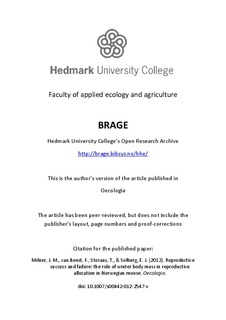Reproductive success and failure: the role of winter body mass in reproductive allocation in Norwegian moose
Original version
Milner, J. M., van Beest, F., Storaas, T., & Solberg, E. J. (2012). Reproductive success and failure: the role of winter body mass in reproductive allocation in Norwegian moose. Oecologia. doi: 10.1007/s00442-012-2547-x http://dx.doi.org/10.1007/s00442-012-2547-xAbstract
A life-history strategy that favours somatic growth over reproduction is well known for long-lived iteroparous species, especially in unpredictable environments. Risk-sensitive female reproductive allocation can be achieved by a reduced reproductive effort at conception, or the subsequent adjustment of investment during gestation or lactation in response to unexpected environmental conditions or resource availability. We investigated the relative importance of reduced investment at conception compared with later in the reproductive cycle (i.e. prenatal, perinatal or neonatal mortality) in explaining reproductive failure in two high density populations in southern Norway. We followed 65 multiparous GPS-collared moose (Alces alces) throughout the reproductive cycle and focused on the role of maternal nutrition during gestation in determining reproductive success using a quasi-experimental approach to manipulate winter forage availability. Pregnancy rates in early winter were normal (≥0.8) in all years while spring calving rates ranged from 0.4 to 0.83, with prenatal mortality accounting for most of the difference. Further losses over summer reduced autumn recruitment rates to 0.23-0.69, despite negligible predation. Over-winter mass loss explained variation in both spring calving and autumn recruitment success better than absolute body mass in early or late winter. Although pregnancy was related to body mass in early winter, overall reproductive success was unrelated to pre-winter body condition. We therefore concluded that reproductive success was limited by winter nutritional conditions. However, we could not determine whether the observed reproductive allocation adjustment was a bet hedging strategy to maximise reproduction without compromising survival or whether females were simply unable to invest more resources in their offspring.
Description
This is the postprint version of the article. The original publication is available at www.springerlink.com
